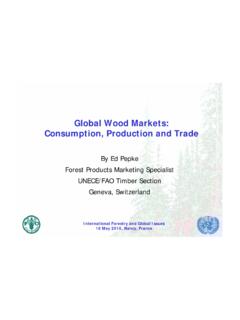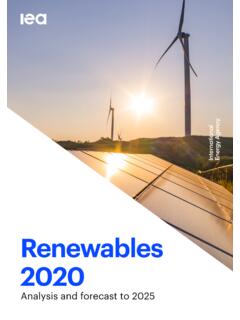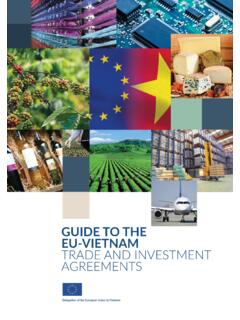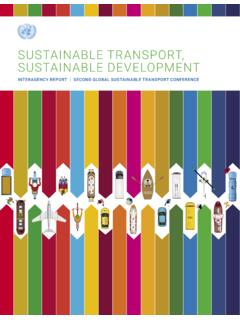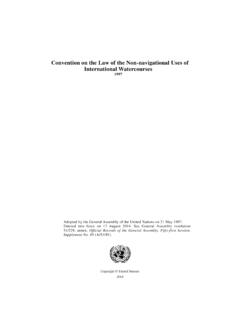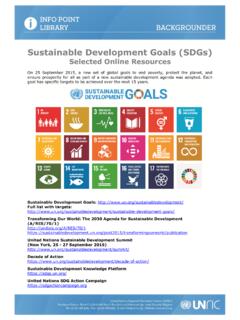Transcription of Emission estimate methodology for maritime navigation
1 Emission estimate methodology for maritime navigation Carlo Trozzi Techne Consulting srl, Via Gregorio Ricci Curbastro, 3 - I00153 Roma, Italy Co-leader of the Combustion & Industry Expert Panel - Task Force on Emission Inventories and Projections, under the Convention on Long-range Transboundary Air Pollution. ABSTRACT The paper reports about the methodology for estimate emissions from navigation , recently updated in the frame of maintenance of the EMEP/EEA air pollutant Emission inventory guidebook1 (the Guidebook). emissions can be estimated at different levels of complexity. In the Guidebook these are expressed in three tiers of increasing complexity (in similar way with the 2006 IPCC Intergovernmental Panel on Climate Change Guidelines for National Greenhouse Gas Inventories).
2 The paper briefly introduces the different tiers and describes in detail the most complete methodology (tier 3) for estimate Emission in cruise (open sea), manoeuvring (approaching harbours) and hotelling (at the dock in port). The methodology uses both installed capacity and fuel consumption as alternative for the emissions estimates and take into account both the main and auxiliary engines. Where fuel consumptions are know the emissions can be computed with fuel related Emission factors for the different navigation phases (cruise, hotelling, manoeuvring). Where fuel consumptions are not know, a specific methodology is proposed for computing emissions based on installed power.
3 Finally, when installed power is not know specific functions are proposed to evaluate installed power from gross tonnage. The functions are derived, for different ship types, using data on about ships from Lloyds register database. Finally simplified methodologies are introduced for use when detailed information is not available. INTRODUCTION A complete methodology for the estimate of air pollutant emissions from ships, in port environment and in navigation , has been developed for the first in the framework of MEET Project (Methodologies for estimating air pollutant emissions from transport) under the transport RTD program of the European Commission fourth framework program2.
4 The methodology was reviewed and updated in 20063. In the last ten years, the general approach adopted by the MEET project was discussed and used with additions and corrections in different contexts4,5,6,7. Actually the EMEP/EEA air pollutant Emission inventory guidebook (Guidebook) and more precisely in Chapter navigation ( navigation chapter), can be considered as a reference for Emission estimate at international level. The Guidebook is designed to facilitate reporting of Emission inventories by countries to the unece Convention on Long-range Transboundary Air Pollution and the EU National Emission Ceilings Directive.
5 It is also recommended by IPCC Guidelines as a source of air pollution Emission factors for the indirect greenhouse gases that Parties report under UNFCCC. The Task Force on Emission Inventories and Projections (TFEIP) is responsible for the on-going maintenance and improvement of the Guidebook's technical content. emissions from navigation can be estimated at different levels of complexity. Within the 2006 IPCC (Intergovernmental Panel on Climate Change) Guidelines for National Greenhouse Gas Inventories (IPCC Guidelines) and adopted by the Guidebook, these are expressed in three tiers of increasing complexity.
6 The Tier 1 method is a simple method using default Emission factors only. To upgrade a Tier 1 to a Tier 2 method, the default Emission factors should be replaced by country-specific or technology-specific Emission factors. This might also require a further split of the activity data over a range of different technologies, implicitly aggregated in the Tier 1 method. A Tier 3 method could be regarded as a method that uses the latest scientific knowledge in more sophisticated approaches and models; more detailed definitions follow.
7 The paper, after recalling the international regulations, reports and discusses the estimate methods (tiers) for the navigation of the Guidebook and related information: literature review of the emissions estimates methodology and Emission factors and statistical analysis of Lloyds database (years 1997 and 2010) for world fleet characterization regarding fuel consumption and others parameters. INTERNATIONAL REGULATIONS The Marine Environment Protection Committee (MEPC) of International Marine Organization (IMO) has approved amendments to Marpol (short for marine pollution, International Convention for the Prevention of Pollution from Ships) Annex VI in October 2008 in order to strengthen the Emission standards for NOx and the sulphur contents of heavy fuel oil used by ship engines.
8 The current Marpol 73/78 Annex VI legislation on NOx emissions , formulated by IMO is relevant for diesel engines with a power output higher than 130 kW, which are installed on a ship constructed on or after 1 January 2000 and diesel engines with a power output higher than 130 kW which undergo major conversion on or after 1 January 2000. The Marpol Annex VI, as amended by IMO in October 2008, considers a three tiered approach as: Tier I: diesel engines (> 130 kW) installed on a ship constructed on or after 1 January 2000 and prior to 1 January 2011; Tier II: diesel engines (> 130 kW) installed on a ship constructed on or after 1 January 2011; Tier III: diesel engines (> 130 kW) installed on a ship constructed on or after 1 January 2016.
9 The Tier IIII NOx legislation values rely on the rated engine speeds (n) given in RPM (revolution per minute). The Emission limit equations are shown in Table 1. For ships operating in a designated Emission Control Area. Outside a designated Emission Control Area, Tier II limits apply. Table 1 - Tier I-III NOx Emission limits for ship engines (amendments to Marpol Annex VI) Tier I limits have to be applied for existing engines with a power output higher than 5 000 kW and a displacement per cylinder at or above 90 liters, installed on a ship constructed on or after 1 January 1990 but prior to 1 January 2000, provided that an Approved Method for that engine has been certified by an Administration of a Party and notification of such certification has been submitted to the Organization by the certifying Administration.
10 In relation to the sulphur content in heavy fuel and marine gas oil used by ship engines, Table 2 shows the current legislation in force. In European Union the legislation is contained in the following directives: Council Directive 93/12/EEC of 23 March 1993 relating to the sulphur content of certain liquid fuels, Official Journal L 074, 27/03/1993; Council Directive 1999/32/EC of 26 April 1999 relating to a reduction in the sulphur content of certain liquid fuels and amending Directive 93/12/EEC, Official Journal L 121, 11/05/1999; Regulation NOx limit (revolution per minute) Tier I 17 g/kWh 45 g/kWh 9,8 g/kWh n < 130 130 n < 2000 n 2000 Tier II g/kWh 44 g/kWh g/kWh n < 130 130 n < 2000 n 2000 Tier III g/kWh 9 g/kWh 2 g/kWh n < 130 130 n < 2000 n 2000 Directive 2005/33/EC of the European Parliament and of the Council of 6 July 2005 amending Directive 1999/32/EC, Official Journal L 191 , 22/07/2005.










